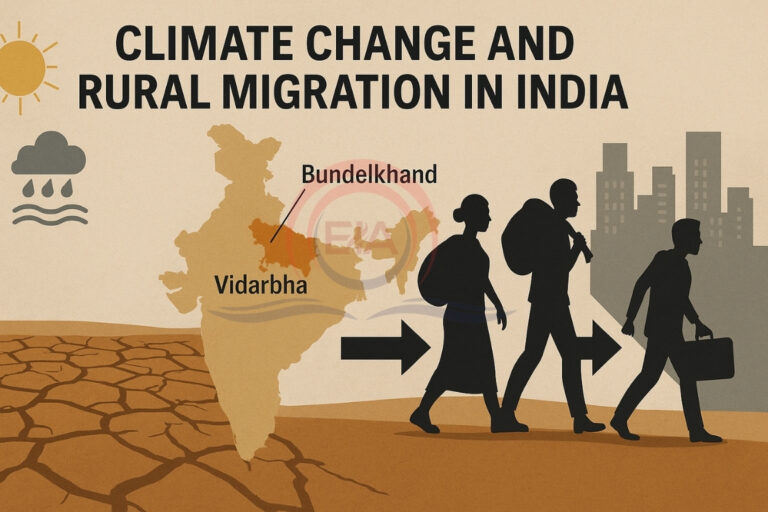Rising climate-related disasters such as droughts and floods are forcing lakhs of rural Indians to migrate, especially from regions like Bundelkhand and Vidarbha, raising concerns about livelihoods, social disruption, and urban challenges.
What is Migration?
Migration means people moving from one place to another, either within a country or to another country—for reasons like jobs, education, safety, marriage, or better living conditions.
It can be temporary or permanent, voluntary or forced.
Types of Internal Migration:
- Rural to Urban – Village to city (most common)
- Urban to Rural – City to village (less common)
- Rural to Rural – One village to another
- Urban to Urban – One city to another

Climate and Migration Link
- Climate change is worsening droughts and floods across India.
- As livelihoods collapse in rural areas, especially in agriculture, people are being pushed to migrate for survival.
Case Study 1: Bundelkhand’s Drought Crisis
- Covers parts of Uttar Pradesh and Madhya Pradesh, known for low rainfall and rising temperatures.
- Panna district in MP has seen declining rainfall and rising heat.
- Districts like Datia, Lalitpur, and Mahoba have faced repeated droughts since the late 1990s.
- Crop failures have deepened farmer debt, forcing many to migrate to cities like Surat, Delhi, and Bangalore.
- Migration has broken village social networks and increased women’s vulnerability.
Case Study 2: River Erosion in Charpauli, Bangladesh
- Annual floods in the Jamuna River wash away homes and land.
- Families are displaced permanently, either to nearby villages or cities like Dhaka.
- A study found the river’s banks eroding by 12–52 metres annually.
Case Study 3: Sugarcane Labour Migration from Vidarbha & Marathwada
- These Maharashtra regions lie in the rain shadow of the Western Ghats and face erratic rainfall.
- Families migrate seasonally to sugarcane farms in western Maharashtra and Karnataka.
- Migrants work under contractual debt bondage, often in poor living conditions.
- Even the elderly are now migrating, a sign of worsening distress.
Migration – Adaptation or Crisis?
- Migration has been viewed by some experts as adaptation to climate change, helping people diversify income.
- However, in the Indian context, especially Bundelkhand, it is seen more as forced displacement than choice.
- Migrants often end up in informal work, urban slums, or in jobs with no security or dignity.
WHAT ARE PUSH AND PULL FACTORS?
- Push factors are the reasons that force people to leave their place of origin.
- Pull factors are the reasons that attract people to a new place.
Push Factors (Reasons People Leave)
These are negative conditions in the home region:
- Unemployment or low income – No job opportunities or poor wages.
- Poverty – Lack of basic needs like food, housing, and healthcare.
- Natural disasters – Floods, droughts, earthquakes, etc.
- Conflict or violence – War, terrorism, or communal unrest.
- Political instability – Corruption, poor governance, or lawlessness.
- Lack of education or healthcare – Poor schools and hospitals in rural areas.
- Environmental degradation – Crop failure, desertification, or pollution.
Pull Factors (Reasons People Arrive)
These are positive conditions in the destination area:
- Better job opportunities – Higher wages and regular work.
- Higher standard of living – Better housing, electricity, clean water, etc.
- Quality education – Good schools and universities.
- Advanced healthcare – Access to hospitals and doctors.
Way Forward
- Strengthen rural climate resilience through better water conservation, crop diversification, and local job creation.
- Recognise migration as a last resort, not a solution.
- Support migrant families with social protection, housing, health care, and education.
Conclusion:
Climate migration in India is a growing humanitarian and development concern. It must be addressed through inclusive rural planning and better protection for vulnerable communities.





